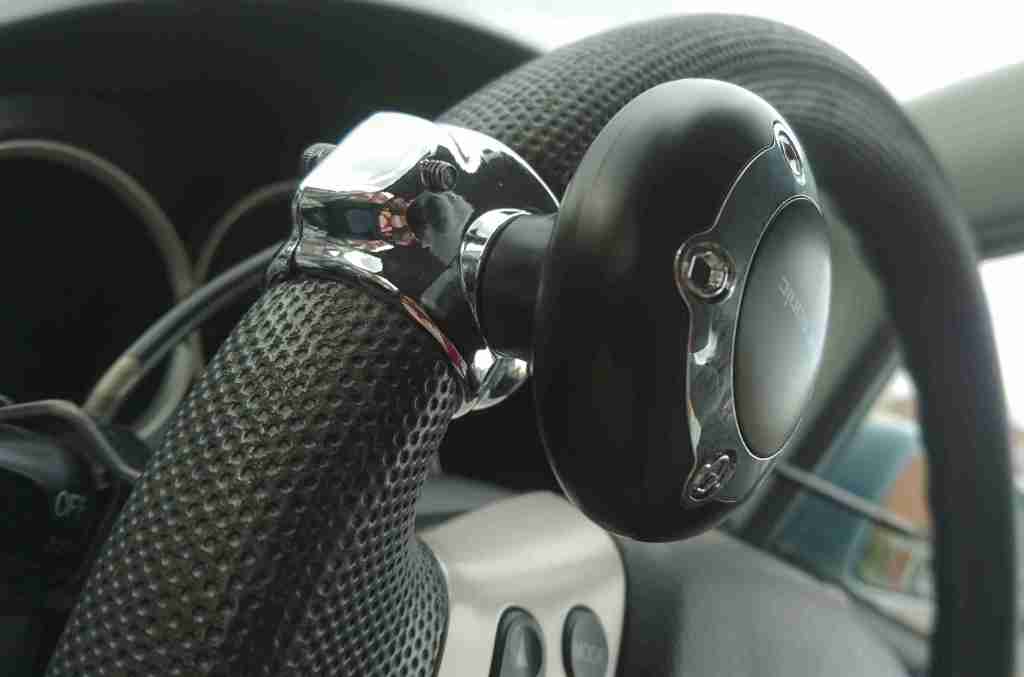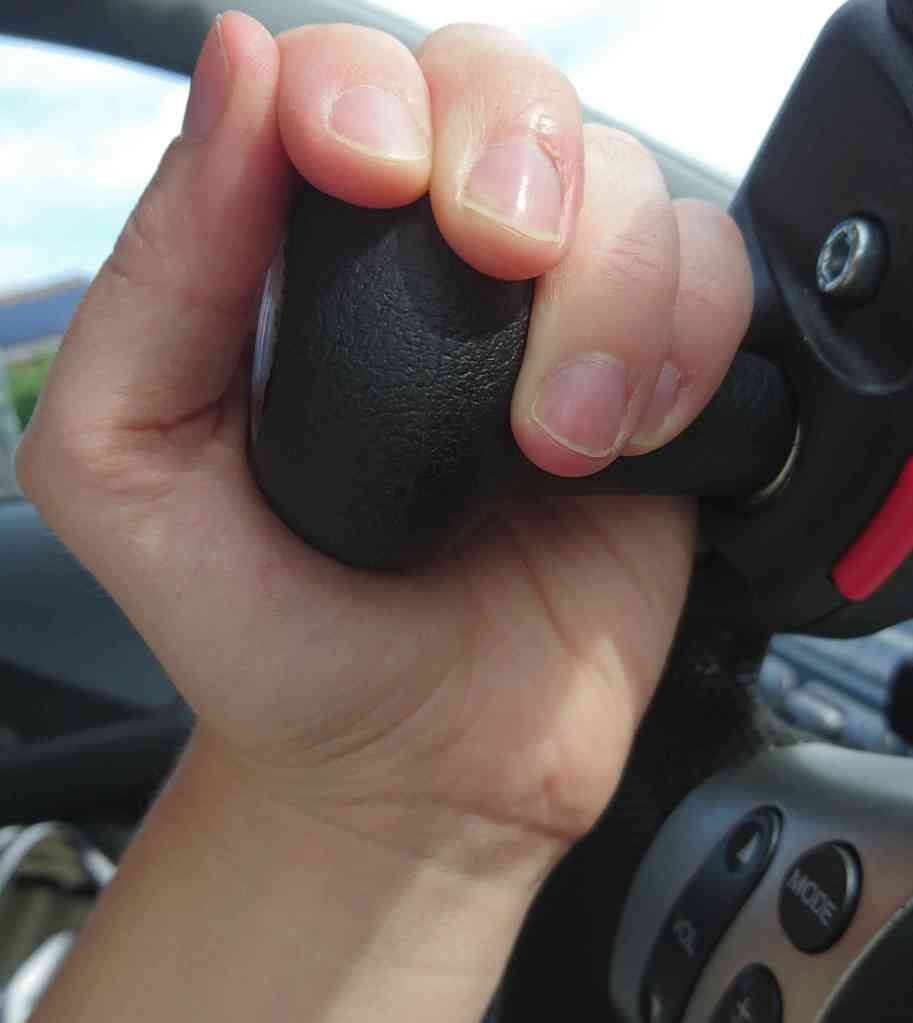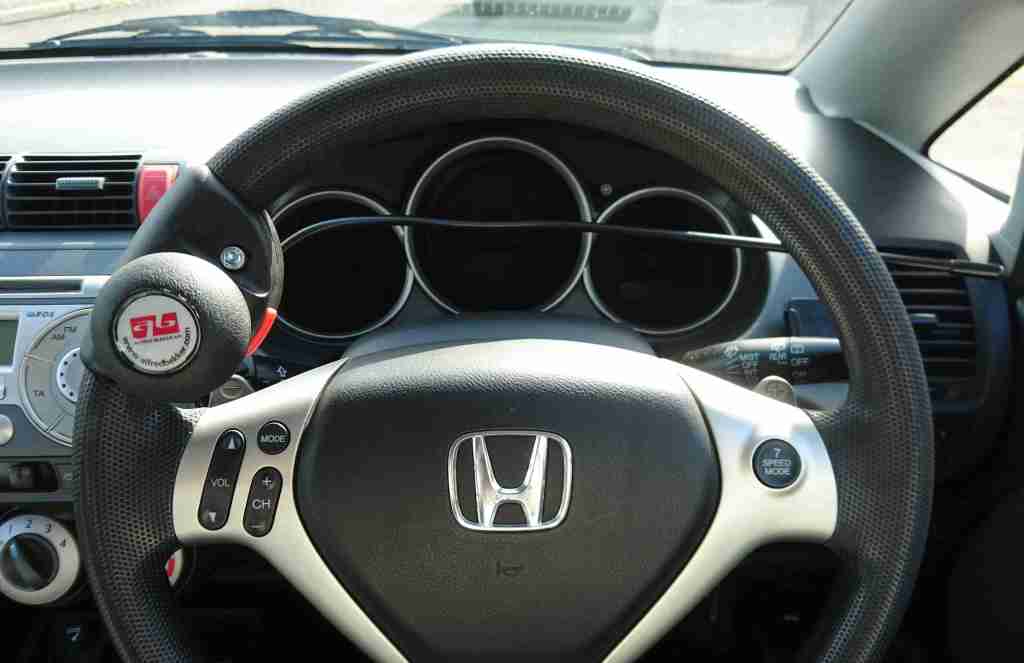I asked Enterprise, Hertz, Avis, Sixt, and Europcar:
1) Can I hire an automatic car with steering aids fitted?
2) Can I fit and use my own steering aids in a hire car?
Below I have outlined which companies it is possible to hire a car from if you are injured or disabled and require steering aids such as a steering spinner or indicator extension.
This information is correct for car hire in the UK as of June 2021.
What are steering aids?
Typically steering aids are removable and bolt onto the steering wheel or indicator stick. They include steering spinners which allow one-handed steering, and indicator extenders which allow control of indicators or windscreen wipers from the opposite side of the steering wheel. Read more about the steering aids I use in order to drive one handed.
Who benefits from steering aids?
Steering aids in combination with automatic transmission enable people with a hand or upper limb disability or injury to drive a car. People with disabilities like arthritis, weak grip, hemiplegia or injuries affecting the hand, wrist, or arm may require steering aids. Aids may help with gripping the steering wheel and controlling the car with one hand.
Are hand controls the same as steering aids?
No- Hand controls replace foot pedals (brake and accelerator) and are designed to help people with lower limb disability. Several car hire companies have information about hand controls on their websites and provide this service for free. Hand controls will NOT make it easier to drive a car if you have a hand or upper limb disability.
Enterprise- Full Support
With 48 hours notice, Enterprise provides Lynx steering aids including a steering ball or quad/tetra grip steering wheel attachment, indicator extension to left side, and assisted hand brake release (as well as hand controls for those with lower limb disability). This service is free.
When I spoke to them on the phone, they also agreed that I could rent an automatic car and attach my own steering aids with less than 48 hours’ notice. The Enterprise website states that they are committed to supporting disabled customers and also offer a free surrogate driver option, and hire of permanently adapted vehicles.
One thing to note is that the Enterprise website says vehicle hire is possible using a debit card. This process requires an approval step and is not possible for all customers.
Avis- Partial Support
Avis do not provide steering aids but would allow drivers to use their own. They did stipulate drivers would be responsible for fitting their own aids for liability reasons, but could ask for assistance with this at the rental office. Their online chat function was helpful and allowed me to get clarification very quickly.
Europcar- Partial Support
Europcar do not provide steering aids but do let drivers provide their own. Their website did not have this information available but it was confirmed by emailing their customer service team.
Sixt- Partial Support
Sixt also do not provide steering aids in the UK, but do allow drivers to bring and fit their own. This information isn’t available online but was confirmed by email.
Support and information for disabled drivers in the US is available at https://www.sixt.com/customers-with-disabilities and states “Sixt is committed to providing a range of Adaptive Driving Devices for our customers with disabilities. Adaptive Driving Devices include left and right hand controls, and spinner knobs”.
Hertz- No Support
Hertz do not provide steering aids, and do not let drivers provide their own. I was told this was because their insurance would not cover it.
Overview
Enterprise had the most detailed and comprehensive options for disabled drivers on their website. If you have a credit card, this is your best bet for making a spontaneous booking.
By contacting customer services, Avis, Europcar and Sixt all confirmed that providing your own steering aids was possible when renting a car. This isn’t an ideal solution for everyone, but does give some additional flexibility and choice of hire company if you already own removable steering aids.
It was very disappointing that Hertz did not provide any options for customers requiring steering aids especially as they are well-known international company.
I would recommend booking car hire over the phone or by email, as most websites do not offer steering aid options as an add-on at checkout. Additionally, individual branch staff might not be aware that steering aids are supported, or what the company regulations are. The option to provide your own steering aids was not a standard anywhere, although when asked, several companies were able to accommodate this. The issue of liability was raised by Avis which highlights the need to get detailed confirmation in writing. Clearer information on car hire websites would be useful and save time contacting customer services.
If you have had a good experience or cautionary tale from hiring a car as a disabled driver, please leave a comment below. So far I’ve learned that research and preparation in advance is key!

























